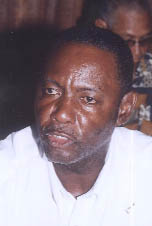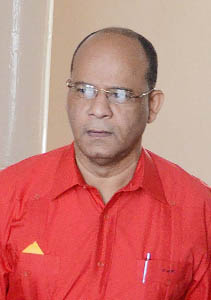-Basil Williams
APNU attorney Basil Williams yesterday pressed for the appearance of Home Affair Minister Clement Rohee before the Commission inquiring into the July 18 fatal shooting of protestors at Linden, saying his evidence could greatly assist its work.
“The minister is the only one who can tell you how he executed policy decisions… he has to tell you about calls to police officers that the records showed that day. There is no way that the minister cannot come because we have questions for the minister in terms of the effective functioning of our police force,” Williams told members of the Commission of Inquiry yesterday.


He pointed out that Rohee could not “escape” making an appearance on the basis that there is no evidence laid against him. “There’s evidence against him anyway, that he called Mr. Hicken immediately after the shooting at the bridge the day, so there’s no way the minister can escape from coming for the purpose of assisting you to make recommendations for a better functioning police force… three senior policemen came to you and each of them gave a contradictory account… people have been killed. We are trying to avoid our people being killed,” the attorney further stated.
Williams reminded the commissioners of their terms of reference, especially two that can be achieved specifically through the minister’s evidence.
“We expect in accordance with the terms of reference that the minister will be here to testify… he would be instrumental in assisting you in making a determination and recommendation for a more effective, functioning police force,” Williams noted.
Attorney Hukumchand, who is representing the Guyana Police Force, opposed the call for the minister, opining that such an application should have been made at the beginning of the inquiry. However, Commissioner KD Knight intervened and pointed out that it was a matter of his assessment of how the inquiry should be run. “You were here at the commencement and at that time you were remarkably silent,” Knight added.
Commissioner Dana Seetahal had also sought clarification, inquiring whether it is the belief of Williams that the Home Affairs Minister is essential. “You’re saying that with relation to the terms of reference, the Minister is necessary… specifically ‘what, if any, specific instructions did the Minister of Home Affairs give to the Guyana Police Force to maintain order in Linden immediately before, during and immediately after the events of July 18, 2012?’” she queried.
Williams pointed out that without Rohee, the commission would not be made aware of the specific directions.
Audio
COI Hearings 25/10/12 Lincoln Lewis
The terms of reference also require the commission to make recommendations and implementation of which will assist the Guyana Police Force in effectively and professionally discharging their responsibilities for the maintenance of law and order in Linden and similar communities without endangering their own safety and that of innocent persons.
Williams further indicated that representation was made in parliament about why members of the Guyana Police Force must quell protest actions with the use of lethal weapons. “Why they have to come with lethal weapons every time the Guyanese people go to protest? We suggested, I particularly, pepper spray, water cannon, shields, rubber bullets…” he noted.
‘I saw the police shoot’
Meanwhile, trade union leader Lincoln Lewis yesterday testified that he saw police shooting in the direction of the Mackenzie-Wismar Bridge.
“I saw the police firing shots in the direction of the bridge… persons got shot… I saw the police shoot. They had guns and they fired teargas and in that process persons were shot with pellets. I saw them taking an aiming position and shoot in the crowd,” he maintained, adding that he saw no rank shoot in the air. Asked whether he would be able to identify any of the ranks he had seen shooting, Lewis said he did not believe so since he does not know them.
He also gave evidence that he had seen a policeman being stopped by another as he was seen in what seemed to be a position to fire his weapon. “I saw an officer in khaki saying, ‘Don’t shoot that man! Don’t shoot that man! Don’t shoot that man’” Lewis said, explaining that he was at the time speaking to a rank dressed in a blue uniform.
He stated that the rank in blue was over at the Linden Secretariat and described him to be about 5 feet and slim. He added that he didn’t actually see the rank shooting at anyone.
“What caused you to believe he was the one being shouted at?” Knight asked. Lewis explained he was of that impression because he saw the rank aim his weapon at a lone man standing in the vicinity of the Linmine Secretariat as well when he heard the shouted orders.
According to Lewis, the Linmine building was not on fire at that time but shortly after, tear smoke was fired and people began shouting that they had been shot.
Lewis also testified that he saw former E&F Division Commander, Senior Superintendent Clifton Hicken with a firearm wrapped in newspaper on the ground at Linden on July 18. A similar claim had been made by Gordon ‘Bad Heart’ Callendar, a contractor and a member of the Linden municipality, when he appeared before the commission on Monday.
However, their descriptions of the gun’s nozzle appeared to differ, causing the commissioners to question the allegation. Callendar, under questioning, had stated that the weapon was “rusty-ish” in colour, while Lewis said that it was “shiny because of the light.”
“So it wasn’t rusty?” Commissioner Seetahal asked, receiving a negative response.
Asked by Knight why he said it was a gun since it was reportedly wrapped in newspaper—an opaque material—Lewis said, “Because I saw it… I saw a part of the nozzle at the front of the gun… protruding the paper.”
“According to what you said, anyone seeing this newspaper would have been able to say he has a gun,” Knight suggested.
“No, it could have been a bottle,” Lewis said, in reply.
Asked if what he saw too could have been a bottle, Lewis said “what I saw was a gun… anyone who was observing would have concluded that it was a gun because that’s what it is… it was an effort to hide it.”
The witness also defended the actions by the protestors in blocking the Mackenzie-Wismar Bridge, while noting that he had not encouraged them to remove from the area and if he was in the situation again, would still not do so. Asked if the police had asked the crowd for their cooperation in clearing the bridge if he would have supported them, Lewis said he would not have done so.
“The blocking of the bridge, the assembling on the bridge, infringe the constitutional rights of others, won’t you agree? Having blocked the bridge, having assembled on the bridge, having prevented other citizens from being able to traverse the bridge as they so desire, was that an infringement of the rights of those who wish to traverse the bridge?” Knight asked the witness.
“It ought to be considered that,” Lewis said, adding that he does not consider it an infringement in the case of Linden.
“If other citizens had prevented you, the protestors, from blocking the bridge, would that have been an infringement of the rights of the protestors?” the commissioner further queried.
“I don’t believe so,” he was told. However, Lewis agreed that the other citizens would have had a right to protect their rights to the freedom of movement.
“Your position is inconsistent and what I had liked about you in giving your evidence is that you appear to be a logical minded person but you have been at this point illogical,” Knight told Lewis.
Attorney Nigel Hughes, who is representing the interest of the families of the three dead men Ron Somerset, Allan Lewis and Shemroy Bouyea, asked the witness whether the bridge had ever been blocked before and he was told on two occasions, prior to July 18. In 1969, Lewis said the bridge was blocked for one night and in 2004, for almost two weeks. “On both occasions the government got involved and negotiated and settled the issue with the citizens,” he stated. Hughes further asked if the then President in 2004, Bharrat Jagdeo, had visited the scene personally, Lewis responded in the affirmative.





